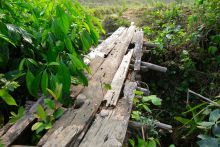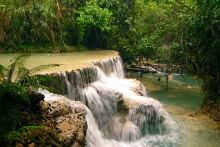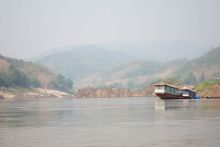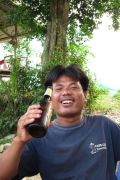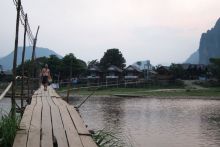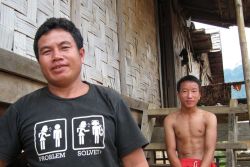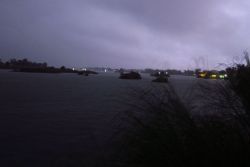Not really up-to-date. I am currently in Kep, Cambodia, but anyways.
Bangkok (bus, 13€) ⇒ Chiang Mai (hitch-hiking, three cars, 0€) ⇒ Pai (via Chiang Mai; hitchhiking, 4 cars, then a local bus; 1.5€) ⇒ Chiang Rai (a local bus, 1.5€) ⇒ Chiang Khong (a boat, 3€, taking into the account the passport adventure) ⇒ Huay Xai, Laos (a slow boat down Mekong with an overnight stopover at Pak Beng, 20€) ⇒ Luang Prabang (minivan, 11€) ⇒ Vang Vieng (bus, 4.5€) ⇒ Vien Tiane (VIP bus, 13€) ⇒ Thakhek (a bus, 6€) ⇒ Pakse (bus, longtail boat, 6€) ⇒ Don Det, 4000 Islands (6€, minivan) ⇒ Champasak (3€, tuk-tuk) ⇒ Pakse ⇒ A three day motorbike adventure around Bolaven Plateau (10€ for motorbike rent and gas) ⇒ Pakse (17€, bus; half a night spent sleeping on the floor in a dodgy place in Lao Bao) ⇒ Hue, Vietnam (4€, minivan)
Total: 118€
Travelling in Laos is very slow. Partly poor infrastructure and sorry state of roads, party the local mentality of doing things slow. The journey from Huay Xai to Vientiane felt like a very long one, but after looking at the map I realized that I did not make much progress at all geographically wise. Travelling in Laos is also more expensive than in Thailand, which is probably due to little competition between companies. Local buses are fascinating. Usually packed to the max with a stack of spare extra chairs placed in the aisle for latecomers. Roof of the bus serves as a storage space for motorcycles and even goats and chicken. How they get those on the roof is something I have never figured out. How goats cope with a journey at 60km/h tied to the roof of the bus is also a mystery to me.
The trip from Don Det to Champasak was particularly memorable. Me and Ben arrived late only to find that there are no seats left. Ben got the crappiest seat and was without a seat at all. People around made jokes that I could see on the floor. My response: “Why not, but I will go make inquiries first”. I went outside and there was this guy who told me that we were in the wrong bus. I go back to get Ben and to much surprise of other travelers we are guided to an A/C minivan with only two of us. What was surprising other travelers to Champasak stayed in a cramped bus. We made it to Champasak river crossing way before other travelers and “wasted” the advantage by sitting by a river before crossing drinking refreshments. Much to annoyance of the travelers from the first bus, who finally showed up later. Go slow travelling!
